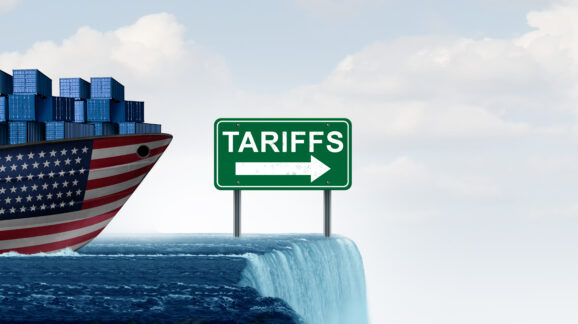That didn’t take long: Tariffs shrink economy in just two months

Photo Credit: Getty
The US is halfway to a self-imposed recession, and tariffs are to blame. A healthy economy started shrinking even before President Trump’s Rose Garden tariffs were announced. The second quarter could be even worse.
Forecasters were already expecting slower growth. For reference, America’s average GDP growth for the entire post-World War II era has been around 2 percent per year. In the fourth quarter of 2024 GDP grew by 2.4 percent, or a little better than average.
Trump’s tariffs and their chaotic implementation led most forecasters to predict about 0.4 percent growth for the first quarter. That’s slow growth, but at least it’s growth. Now it turns out the economy actually shrank by 0.3 percent in the first quarter. That is a rapid change of fortune—literally, considering the $6 trillion of value that financial markets have lost since Liberation Day.
Up to now, most recession indicators were at roughly 50-50. This was likely an understatement. We will not know for sure about a recession for at least another three months. But if the economy was already shrinking in the first quarter of 2025, then the second quarter could be brutal.
One reason forecasters were still expecting first-quarter growth is because they expected a midnight rush of people buying up goods like cars, clothing, and electronics before tariff increases took effect. But even with pre-tariff hoarding, the economy still shrank. This does not bode well, especially since any midnight rush effect would later be offset by a post-tariff slowdown in demand.
Also boding poorly is that the Trump’s April 2 Liberation Day tariffs were larger than expected. Markets already priced in anticipated tariff damage during the first quarter. But few people expected the largest tariffs since the Great Depression’s Smoot-Hawley tariffs, and the largest overall tax increase in more than 30 years, plus retaliatory tariffs from around the world.
Shipping traffic from Asia is already slowing, and UPS has already announced layoffs. Shortages will in turn affect manufacturing, retail, and other industries, and could last for as long as Trump’s tariffs do. Supply chains take years to reroute, and companies were in some cases given eight hours’ notice.
Some relief is coming, but not enough. Trump has delayed some of his tariff increases and reduced others, but not all the way. This is an important point. As economist Don Boudreaux points out, these partial drawbacks are similar to arguing that “we should be grateful to an armed robber who, after initially demanding that we fork over $1,000 of our hard-earned money, announces that he’s kindly offering us a little time to transition by temporarily reducing his demand to $300, but also assuring us that he’ll return soon for the remaining $700.”
So when the administration announces a tariff walkback, as it did yesterday on autos, don’t compare it to the originally announced increase. Compare it to pre-Trump rates. If it’s still higher, then Trump has raised tariffs on net, and Americans are still worse off on net.
Trump is unlikely to change his mind on tariffs. His protectionism is gut-level, and seemingly immune to persuasion. His economic advisers seem reconciled to this, making more sophisticated but often contradictory arguments for tariffs. The nation’s economy instead depends on Congress and the courts to take away tariff-making powers that should never have been delegated to the executive in the first place. I argued this point back in 2020, and it is difficult to find a polite way to say “I told you so.”
The shrinking economy puts congressional Republicans in an uncomfortable place. They want to follow their president, but doing so is putting their jobs at risk. Price increases, whether from inflation or from tariffs, are very unpopular with voters.
Trump and Republicans own the tariff issue, and voters are eager to let their representatives know how they feel about paying higher prices. Just as inflation was the number one reason why the Biden-Harris administration lasted one term, tariffs are why the GOP’s congressional majority days are probably numbered if they don’t get tariffs back to pre-Trump levels.
The Constitution gives all taxing power to Congress, and none to the president. Today’s GDP news shows why this was a good arrangement. Court challenges to the tariffs look promising, but will take some time to wind through the courts. Congress could act today if it wanted to, and legislation already exists, but both sides of the aisle would have to be united in a way they have not been for some time to override a veto.
Until someone stands up to the president, Americans will pay the highest tariffs in the developed world, and America’s self-inflicted potential recession could become even worse.